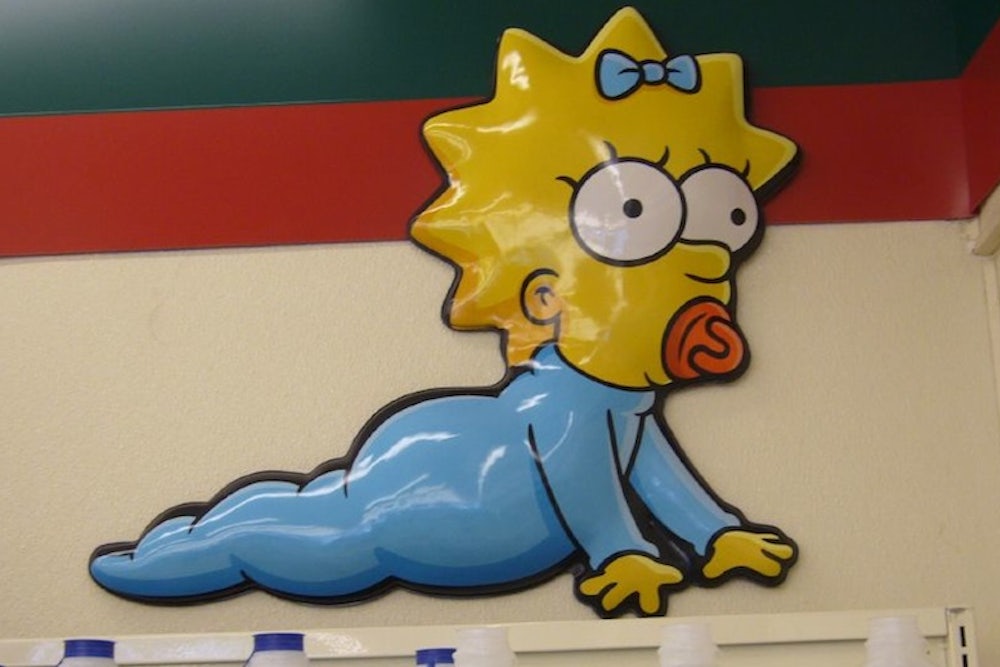In spite of having a father who eats pie off the floor and strangles his ten-year-old son, Maggie Simpson has for 25 years shown herself to be a precocious and intelligent one-year-old. But if Marge and Homer don’t take the pacifier out of her mouth, her emotional development might suffer. A new paper, published in the journal Basic and Applied Social Psychology and reported on Monday in the British Psychological Society’s Research Digest blog, suggests that pacifiers may hamper the emotional bond between babies and their caretakers. A team of psychologists at the University of Wisconsin-Madison, Oglethorpe University in Georgia, and Clemont Universite in France recruited 29 women online and monitored their facial reactions with electrodes as they viewed photographs of emotive babies either with pacifiers, with white squares covering their mouths, or with nothing obstructing their faces. (The experiment focused on female subjects because women are better at reciprocating facial emotions.) The babies displayed one of three emotions—happiness, sadness, or anger—or a neutral expression, and the women had to try to rate the intensity of the baby’s emotion.

When the women looked at happy babies with a pacifier or with a white square obscuring their mouth, they showed less activity in their Zygomaticus—the muscle responsible for drawing the mouth into a smile—and they also believed the babies’ happiness was less intense. When the women looked at pictures of babies who were sad or angry, facial obstruction by a pacifier or a square again caused the women to rate the babies’ feelings as less intense. Regardless of the babies’ emotion, the womens’ reciprocal facial expressions were muted when the babies’ faces were partially covered.
Throughout the experiment, it didn't make a difference whether a pacifier or a white square was used to hide the baby's mouth; adults' emotional responses were similarly dampened either way. This suggests that the women's responses to the babies with pacifiers were less intense not because of negative stereotypes about infants with pacifiers—the researchers hypothesize that adults may believe that only difficult or whiny babies are given pacifiers—but because the baby's mouth was covered.
The implications for babies’ emotional development could be significant. “The relationship between facial activity and the corresponding experience of emotion is particularly important for preverbal infants, because they rely on facial expressions of caretakers for behavioral regulation and learning,” write the authors. “Perceivers may find interactions with infants using a pacifier less enjoyable and less stimulating. ... Smiles are powerful social rewards … and sadness, despite its negative valence, elicits talk, play, and supportive behavior of adults.” Adults—whether caretakers or not—could feel less inclined to fully engage with infants using pacifiers, and the infants themselves may benefit less from the interaction if they’re unable to mimic the adults’ emotions.
This paper builds on a 2012 study by the same team, which found a correlation between longer pacifier use as infants and signs of reduced emotional engagement in boys at different stages: At six and seven years old, boys who had used pacifiers for a longer period of time found it more difficult to mimic the facial expressions of adults in videos, and 18-year-old men who had used pacifiers for an extended period scored lower on tests of emotional intelligence. Girls appeared to be more resistant to the negative effects of pacifiers; the researchers hypothesized that they have more alternative opportunities to develop their emotional intelligence, since their parents might be more likely to talk with them about emotional ideas. (The present study did not differentiate between male and female babies.)
Homer and Marge Simpson make many unconventional parenting decisions, but their use of a pacifier is pretty mainstream. A study in 2000 found that 75 to 85 percent of parents in Western countries rely on pacifiers at least occasionally. They were first recommended by doctors in the fifteenth century, and parents have been documented putting corn cobs and bits of cloths into their babies’ mouths to quiet them. According to the Oxford English Dictionary, the first written use of “pacifier” with its contemporary meaning occurred in 1901, in an advertisement in the Atlanta (Georgia) Constitution.
But parents don’t necessarily have to throw away their babies’ pacifiers just yet. “The takeaway is to think about when you’re using it and why you’re using it,” said Paula Niedenthal, a social psychologist at the University of Wisconsin-Madison who co-authored the paper. “Sometimes people use pacifiers when they’re walking down the street and the baby’s in the stroller and there’s no possibility of emotional resonance anyway; the baby’s not facing anyone or having any direct interactions.” But if you’re sticking a pacifier in your baby’s mouth during playtime, says Neidenthal, “You might want to think about that one”; you could be preventing the baby from making the most of a chance for social learning.
